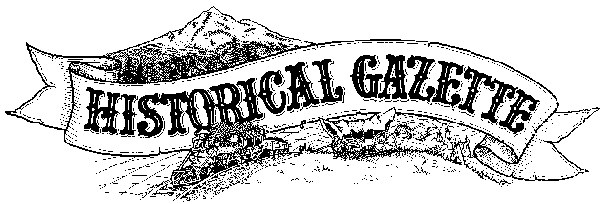Volume One, Number One
Celebrated Geologist Visits Blue Mountains
Sumpter, Oregon 1900
Professor Waldemar Lindgren Reports on Gold Camps Swedish born economic geologist studies the rocks & mountains for the U.S. Geological Survey The following story is extracted from report being prepared by W. Lindgren for the U.S.G.S. to be published as soon as he returns to the East. His field experience includes a visit to the famous Mother Lode of California and his reports are thought to be the best detailed of anything available.
Bonanza Mine "Though some gold-quartz veins are known from the head of Gimlet Creek and other places on the divide toward Granite Creek and Sumpter, the old place in which they appear strongly developed and in which they have been mined with success is the Bonanza District.
"The Bonanza Mine is situated about 10 miles west of Sumpter on the head waters of Burnt River at an elevation of 5,140 feet. The first locationis said to have been made in 1877 by a pioneer prospector named Jack Haggard, who sold it in 1879 for $350 to the Bonanza Mining Co. In 1892, the mine was bought by Geiser brothers for a reported sum of $3,000 and worked by them until 1898, when it was sold to the present owners, a Pittsburgh, Pa. for a price believed to have been $500,000. When sold, $300,000 in ore is believed to be in sight. Since 1898, at least an equal amount has been extracted, making a total production well up toward the million dollar mark.
"The developments consists of two tunnels, the upper 1,400 long and 230 feet below the croppings, the lower 1,600 feet long, the latter is the main adit, 338 feet below the croppings, and a shaft is sunk in it 600 feet from the mouth to a depth of about 200 feet. Further sinking is being carried on at the present time. In all, there are probably 10,000 feet of development work.
"The country rock is a fissile black clay slate, striking nearly due east west and dipping 80 degrees South. A little above the town of Geiser, at the mill, this slate is cut by a considerable belt of serpentine. The same rock appears again below Bonanza, toward the diggings of Winterville. To the north and east, the serpentine and clay slate are covered by an andesitic lavas. The veins appear to be exclusively contained in clay slate. The Bonanza vein, cropping on a hill, 500 feet above the mill, and about half a mile northeast of it, strikes north 50 degrees West, and dips steeply southwest. It is traceable on the surface for about 2,500 feet northwest of the main tunnel, but is then covered by an extensive lava area.
"The outcrops are neither wide nor conspicuous, and have been stoped to the surface in several places. The vein appears as one to three feet of quartz between walls of decomposed slate. In depth it widens enormously in places.
"Permission to visit the mine below tunnel level was refused. The following data relating to the underground works were obtained from several persons well acquainted with the mine, and are believed to be mainly correct:
"The ore consists of quartz containing free gold and sulphuretes and has considerable simularities to that of the Red Boy mine. The ore body as a whole forms a mass of clay slate traversed by quartz veins and seams of all sizes. Something like 70 percent is free gold, though it is said that as the depth is increased more concentrates and less are obtained. The concentrates are said to vary from $20 to $60 per ton, chiefly in gold. The average ore is believed to run from $7 to $12 per ton, but lenses of ore eight to 16 inches wide have been mined which ran as high up as $1,400 per ton, and several hundred tons are said to have yielded at the rate of $100 in free gold per ton."
"It seemed as if the mine was worked out when the owners were prevailed upon to cross cut at other places in this adit. These cross cuts from 30 to 120 feet long, into the foot wall side disclosed the presence of a magnificent lenticular mass of (gold) ore of a maximum width of 40 feet and 800 feet long."
The above story is only one of several from our first edition. Read our bio on Waldemar Lindgren or visit another gold camp: Cracker Creek, Oregon.Read our other gold mining editions:
[Baker City, 1899 | Gold Seekers Rush to California]
[Oregon: Land of Gold & Opportunity | Stories from the Comstock]

Bridget E. Smith, editor & publisher
Email | Home Page | Historic Headlines
Historical Gazette
Published in Portland, Oregon
© 1991-

